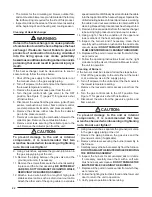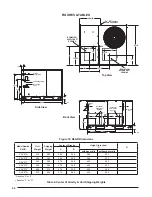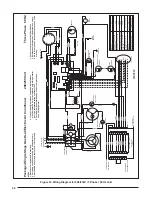
15
• The thermostat should be mounted about 5 feet above the
fl oor on an inside wall. DO NOT install the thermostat on
an outside wall or any other location where its operation
may be adversely affected by radiant heat from fi replaces,
sunlight, or lighting fi xtures, and convective heat from
warm air registers or electrical appliances. Refer to the
thermostat manufacturer’s instruction sheet for detailed
mounting information.
Checking Heat Anticipator Settings
• Add the current draw of the system components.
OR
• Measure the current fl ow on the thermostat R-W circuit
after the circulating blower motor has started. Set the heat
anticipator according to the thermostat manufacturer’s
instructions for heat anticipator settings.
Optional Outdoor Thermostat
If two stage heating is desired, an outdoor thermostat
can be installed in the fi eld with 2-stage electric heat. To
install the outdoor thermostat, remove the orange wire
from the E terminal on the terminal block, and connect
to the outdoor thermostat. Connect the other side of the
outdoor thermostat to W2 from the thermostat.
Blower Speed
The blower speed is preset at the factory for operation at
the same speed for heating and cooling. These factory
settings are listed in Table 10 (page 25). For optimum
system performance and comfort, it may be necessary
to change the factory set speed.
CAUTION:
To avoid personal injury or property damage,
make sure the motor leads do not come into
contact with any uninsulated metal components
of the unit.
1. Shut off all electrical power to the unit and remove the
blower panel. Locate the orange, red and blue wires
terminated to the blower motor. NOTE: The orange wire
controls cooling operation while the red wire controls
heating operation. The blue wire controls fan-only
operation.
2. Verify the required speed from the airfl ow data found in
Table 10. Place appropriate wire on the correct motor
speed tap for the required airfl ow point.
3. The integrated furnace control can be set to a 2 or 3
speed mode. When a G only call is received from the
thermostat (indicating a continuous fan mode), the
blower will run the heating speed when the 2-SPD
mode is selected using the jumper on the control
board (factory setting). When 3-SPD mode is selected,
the fan only speed may be different than the heating
or cooling speed. If no jumper is present, the control
defaults to the 2-SPD mode of operation. A call for
heating or cooling takes priority over fan only mode
Example
:
AB = 451V
BC = 460V
AC = 453V
2. Determine the average voltage in the power supply.
3. Determine the maximum deviation:
4. Determine percent of
voltage imbalance by
using the results from
steps 2 & 3 in the following
equation.
max voltage deviation
from average voltage
= 100 x
average voltage
% Voltage Imbalance
6
454
100 x
= 1.32%
Example:
1. M e a s u r e t h e l i n e
voltages of your 3-phase
power supply where it
enters the building and
at a location that will
only be dedicated to the
unit installation. (at the
units circuit protection or
disconnect).
Unbalanced 3-Phase Supply Voltage
Voltage unbalance occurs when the voltages of all phases
of a 3-phase power supply are no longer equal. This
unbalance reduces motor effi ciency and performance.
Some underlying causes of voltage unbalance may include:
Lack of symmetry in transmission lines, large single-phase
loads, and unbalanced or overloaded transformers. A
motor should never be operated when a phase imbalance
in supply is greater than 2%.
Perform the following steps to determine the percentage
of voltage imbalance:
In this example, the measured line voltages were
451, 460, and 453. The average would be 454 volts
(451 + 460 + 453 = 1,364 / 3 = 454).
The amount of phase imbalance (1.32%) is satisfactory
since the amount is lower than the maximum allowable
2%. Please contact your local electric utility company if
your voltage imbalance is more than 2%.
Example:
From the values given in step 1, the BC voltage
(460V) is the greatest difference in value from
the average:
460 - 454 = 6
454 - 451 = 3
454 - 453 = 1
Highest Value
















































